 From Hell appears in an aspect ratio of approximately 2.35:1 on this single-sided, double-layered DVD; the image has been enhanced for 16X9 televisions. Overall, the DVD offered a very solid picture that displayed no distinct concerns.
From Hell appears in an aspect ratio of approximately 2.35:1 on this single-sided, double-layered DVD; the image has been enhanced for 16X9 televisions. Overall, the DVD offered a very solid picture that displayed no distinct concerns.
Sharpness seemed excellent. From start to finish, the film remained crisp and well defined. I saw no signs of softness or fuzziness, as the movie consistently appeared distinct. Jagged edges and moiré effects caused no problems, and I also noticed no signs of any edge enhancement. In regard to print flaws, I discerned a couple of speckles, but that was it; otherwise the image seemed very clean.
Colors offered a highlight. The hues presented warm and vibrant tones that always came across as clear and vivid. At times they appeared almost hyper-real, and they positively glowed throughout the movie. Black levels also seemed deep and rich, while shadow detail was appropriately heavy without any excessive thickness. All in all, From Hell provided an excellent viewing experience.
Also very good were the film’s soundtracks. We found both Dolby Digital 5.1 and DTS 5.1 mixes on this disc. For the most part, I thought they sounded quite similar. The DTS version displayed slightly stronger bass response, but the differences seemed minor. I didn’t think the disc showed enough variations to merit a distinction between my grades.
 During most of the film, the soundfield maintained a fairly high emphasis on the forward channels. Within that spectrum, the track showed good stereo presence for the music and also created a solid sense of atmosphere. Elements seemed to be accurately placed in the forward spectrum, and the pieces moved naturally across the soundstage. As for surround usage, the rear speakers added good reinforcement for the music and effects, and they often added their own sounds. Fir the most part, they offered general ambience, but they came to life nicely at times, especially during Abberline’s dream sequences.
During most of the film, the soundfield maintained a fairly high emphasis on the forward channels. Within that spectrum, the track showed good stereo presence for the music and also created a solid sense of atmosphere. Elements seemed to be accurately placed in the forward spectrum, and the pieces moved naturally across the soundstage. As for surround usage, the rear speakers added good reinforcement for the music and effects, and they often added their own sounds. Fir the most part, they offered general ambience, but they came to life nicely at times, especially during Abberline’s dream sequences.
Audio quality appeared solid across the board. Dialogue seemed natural and distinct, with no signs of edginess or problems related to intelligibility. Effects were clean and accurate, as they showed bright highs and rich low-end response. The overall dynamics of the piece seemed positive, and these also appeared via the music. That aspect of the track sounded vivid and clear, with solid fidelity and depth. Ultimately, I thought the audio lacked the sonic ambition to merit an “A”-level rating, but From Hell still provided strong sound.
For this two-DVD set, most of the extras appear on the second disc. However, DVD One tosses in a few tasty treats. First we find an audio commentary from directors Allen and Albert Hughes, screenwriter Rafael Yglesias, actor Robbie Coltrane, and cinematographer Peter Deming. All were recorded separately for this edited piece. The variety of participants means we get a nice mix of material, and this seems like a pretty solid little commentary.
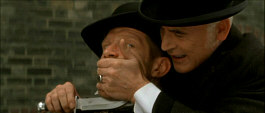 Somewhat surprisingly, screenwriter Yglesias dominates the track. He goes over a lot of information that relates to facts of the case as well as changes that occurred to the script, especially those that came between the original graphic novel and the movie. The other contribute a lot of notes as well; it just seemed surprising that the directors didn’t offer the majority of the details. In any case, as a whole this is a quite useful and entertaining commentary.
Somewhat surprisingly, screenwriter Yglesias dominates the track. He goes over a lot of information that relates to facts of the case as well as changes that occurred to the script, especially those that came between the original graphic novel and the movie. The other contribute a lot of notes as well; it just seemed surprising that the directors didn’t offer the majority of the details. In any case, as a whole this is a quite useful and entertaining commentary.
Also on DVD One is a collection of 21 Deleted Scenes. These last between 27 seconds and two minutes, 11 seconds for a total of 23 minutes and 51 seconds of footage. In a nice touch, each of the clips shows the new material in color, while bits from the final film appear in black and white to differentiate them. Overall, I found these scenes to seem moderately interesting at best. Even the alternate ending isn’t anything special, though it does include some female nudity - uh, if any cares about that! Ultimately, the shots merit a look, but none of them appears too special.
The deleted scenes can be viewed with or without commentary from director Albert Hughes. He adds good remarks about each of the snippets. Hughes doesn’t tell us too much about them other than the reasons for their excision, but that’s enough for me. His statements add to the piece. (By the way, even if you don’t want to listen to all of his notes, at least check out his funny material about the alternate ending.)
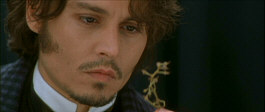 The final extra on DVD One is the THX Optimizer. Also found on discs like The Phantom Menace and Willow, it purports to help you set up your home theater to best present the movie on the disc in question. Apparently the Optimizer is unique for each DVD on which it’s included; unlike programs such as Video Essentials, the Optimizer should tweak your set-up differently every time. Frankly, I’ve been very happy with my already-established calibration and I’m afraid to muck with it, so I’ve never tried the Optimizer. If you lack calibration from Video Essentials or a similar program, or if you’re just more adventurous than I am, the Optimizer could be a helpful addition.
The final extra on DVD One is the THX Optimizer. Also found on discs like The Phantom Menace and Willow, it purports to help you set up your home theater to best present the movie on the disc in question. Apparently the Optimizer is unique for each DVD on which it’s included; unlike programs such as Video Essentials, the Optimizer should tweak your set-up differently every time. Frankly, I’ve been very happy with my already-established calibration and I’m afraid to muck with it, so I’ve never tried the Optimizer. If you lack calibration from Video Essentials or a similar program, or if you’re just more adventurous than I am, the Optimizer could be a helpful addition.
That finishes the first disc, so we now move to DVD Two, which offers a wealth of video options. The lengthiest of these is called Jack the Ripper: Six Degrees of Separation. Touted as an “interactive investigation”, this piece offers a main program that runs for 30 minutes and 35 seconds. For that period, we see many photos, drawings and other historical artifacts that relate to the Ripper case and we hear narration from historians Stewart P. Evans and Donald Rumbelow; Allen Hughes briefly appears to tout a humorous theory as well. Essentially, the show covers the different murders and runs through all of the possible suspects. “Separation” gives us a nice look at the facts of the case.
The “interactive” part of “Separation” occurs sporadically during the piece. On nine occasions, a magnifying glass appears on screen. Hit “enter” on your remote and you’ll see a relevant snippet, usually from an unidentified documentary about the Ripper. I’d estimate this came out in the early Eighties, but we never learn anything about it or its participants. Nonetheless, it adds some good material. Some of it seems redundant, but enough of it appears new to this program that it merits a look. Each clip lasts between 30 seconds and five minutes, 43 seconds for a total of 24 minutes and 38 seconds of footage. I don’t think these bits are crucial, but they’re there if you want them.
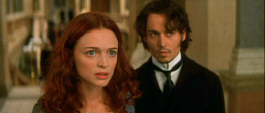 Two notes: first, I think it’s best to watch “Separation” straight through and then revisit it for the extended pieces. If you view them during the main program, the pacing becomes confusing. In addition, make sure you check out these segments on an empty stomach. Some of the photos are quite gruesome.
Two notes: first, I think it’s best to watch “Separation” straight through and then revisit it for the extended pieces. If you view them during the main program, the pacing becomes confusing. In addition, make sure you check out these segments on an empty stomach. Some of the photos are quite gruesome.
Next up we get some information about the Graphic Novel on which the movie was based. We hear from Allen and Albert Hughes plus producer Don Murphy during this nine-minute and 55-second piece. Mostly we learn how the film differs from its inspiration, and we see a fair amount of material from the comic. It’s a good look at the changes between the two.
In Absinthe Makes the Heart Grow Fonder, we learn about Inspector Abberline’s favorite drink. This nine-minute and 55-second featurette features interviews from Barnaby Conrad, (author of Absinthe History in a Bottle), aficionado Ian Hutton, and Jeremy Hill, absinthe marketer. Personally, this show didn’t do much for me, as I really didn’t care about absinthe. However, it’s always better to learn too much than too little, so I appreciated the inclusion of this well-produced program. It offers a good look at this unusual element of the film.
Not surprisingly, Production Design focuses on that element of the shoot. We hear from the Hughes brothers, executive producer Amy Robinson, and production designer Martin Childs. For obvious reasons, the latter participant dominates the program, as we learn about the set and the various locations. It’s a nice discussion about the process, and it also contributes a few interesting behind the scenes shots from the set.
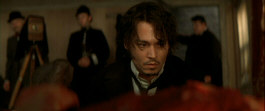 In a similar vein comes a Tour of the Murder Sites. Conducted by the Hughes brothers, this seven-minute and 45-second program shows the directors as they walk through the relevant parts of the set. Overall, it’s an amusing and informative glimpse behind the scenes.
In a similar vein comes a Tour of the Murder Sites. Conducted by the Hughes brothers, this seven-minute and 45-second program shows the directors as they walk through the relevant parts of the set. Overall, it’s an amusing and informative glimpse behind the scenes.
After this we get trailers for From Hell and the upcoming theatrical release of Unfaithful plus a program called A View From Hell. Hosted by Heather Graham, this 14-minute and 30-second featurette includes the standard mix of film clips, shots from the set, and interviews. In the latter category, we hear from the Hughes brothers, actors Johnny Depp, Graham, Robbie Coltrane, historical consultant Stewart Evans, production designer Martin Childs, producer Don Murphy, executive producers Amy Robinson and Thomas M. Hammel, and “Ripperologist” Richard Jones. Though the program’s too short to offer much depth, it nonetheless seems better than average for this genre. We see some good behind the scenes clips as well as a reasonable amount of useful information from the interviews. They quickly run through the story and the characters, but mostly the featurette flies through Ripper history, working with the directors, the sets, and a number of other topics. For what it is, “View” offers a brisk and entertaining program.
I wish I could say the same for the movie itself. While From Hell had its moments, the film seemed surprisingly flat and ordinary. It lacked much tension and even though I am a fan of the genre, it rarely got me interested in the proceedings. The DVD offered very positive picture, sound, and extras, however; it seemed like a thoroughly terrific piece of work. For those who like this sort of flick, From Hell still merits a look; maybe you’ll like it more than I did, and the DVD certainly makes it a very appealing package.
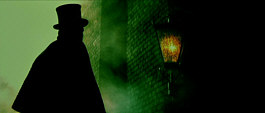 Note that this review covers the “Directors’ Limited Edition” release of From Hell. In early 2002, Fox announced that they would phase out many of their 2-DVD special editions and ultimately replace them with single-disc fare. I believe that From Hell is their first release that tells us of its truncated shelf life up front; we’ve been told from day one that this sucker won’t be around forever. When the new version appears, apparently it’ll duplicate this one’s first disc, which means we’ll still get the audio commentary and the deleted scenes. The second platter will get the boot, however. I don’t know the exact timetable for this change, but I thought I should mention it.
Note that this review covers the “Directors’ Limited Edition” release of From Hell. In early 2002, Fox announced that they would phase out many of their 2-DVD special editions and ultimately replace them with single-disc fare. I believe that From Hell is their first release that tells us of its truncated shelf life up front; we’ve been told from day one that this sucker won’t be around forever. When the new version appears, apparently it’ll duplicate this one’s first disc, which means we’ll still get the audio commentary and the deleted scenes. The second platter will get the boot, however. I don’t know the exact timetable for this change, but I thought I should mention it.



